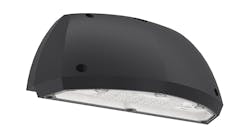LED lighting vendor Glamox has started to use recycled rather than new aluminum in some of its luminaires in an effort to help reach its promised net zero greenhouse gas operations by 2030.
The Norwegian firm has already made the replacement on its C80 range, and plans to do the same on its C35 and C95 lines.
Aluminum production is a highly energy intensive process, involving considerable electricity and CO2 emissions during at least two stages: extracting alumina from bauxite ore, and then smelting it into aluminum metal. Both processes require temperatures well over 900°C. The mining and cleansing of bauxite incurs additional environmental costs as well.
Aluminum recyclers melt the metal for reshaping and reuse. Estimates of how much energy it saves can vary, ranging to over 90%. Glamox claims that with the switch, it will reduce emissions of “CO2 equivalents” from manufacturing of the relevant models by 63%.
Glamox produces the three luminaires in Keila, Estonia.
“We’ve already implemented the plan to shift over to recycled aluminum in the manufacture of a popular luminaire which will result in a 63% reduction in the emissions of CO2 equivalents over using new aluminum in these profiles,” said Birger Holo, technical director for professional business solutions at the Oslo-based company. “By adding two new product lines we estimate that we will eliminate a total of 1,000 [metric] tonnes of CO2 equivalents each year, which equals the amount of carbon sequestered by nearly 1,200 acres of forest a year.”
Glamox has established a goal of reaching net zero by 2030. To achieve net zero, a company, government, or group balances its greenhouse gas emissions with the amount of greenhouse gas it sequesters through means such as planting trees, supporting forests, restoring peatlands, and carbon capture. (Ocean sequestration is another method, although CO2 is associated with the hazard of ocean acidification).
The United Nations has established 2050 as the goal for global net zero in order to, in its words, “avert the worst impacts of climate change and preserve a livable planet.” It set its 2050 deadline as part of the Paris Agreement at the 2015 United Nations Climate Change Conference (COP21), where it also set a target of 45% reduction in emissions by 2030.
Some entities such as Glamox have established more aggressive deadlines. Signify has described its own climate program as one that doubles the pace of the Paris Agreement. And in a recent interview with LEDs Magazine, Acuity Brands CEO Neil Ashe described the organization’s progress in minimizing its carbon emissions, noting that Acuity has committed to net zero by 2040 under the Science Based Targets Initiative.
The UN has stated a preference for emission reductions over sequestration. It has noted that much of the reduction has to come from the energy generating sector.
Measures such as Glamox’s use of recycled aluminum are a solid step in the direction of reducing emissions.
But for emissions themselves to get close to zero — to carry the lion’s share over sequestration in the net zero formula — carbon-light methods much be used. In high-temperature manufacturing processes, those might involve hydrogen, or the less discussed method of using heat from nuclear reactors.
While reactors today are primarily used to generate electricity, the heat they emit — typically used to make steam for electricity turbines — could also power industrial processes which today rely on fossil fuels, notorious for their climate damage.
“We still have a lot of work ahead of us, but we are committed to helping our customers to reduce their carbon footprint and for us to achieve net zero operations by 2030,” said Glamox business development manager Viktor Söderberg, who runs the company’s sustainability program. “It’s not enough providing energy-efficient LED lighting; we must ensure that every facet of our operations and supply chain minimizes our environmental impact.”
On a related note, the UN has warned that the planet is currently not on track to meet the 2050 net zero deadline.
“Commitments made by governments to date fall far short of what is required,” the UN states on its website. “Current national climate plans — for 193 parties to the Paris Agreement taken together — would lead to a sizeable increase of almost 11% in global greenhouse gas emissions by 2030, compared to 2010 levels. Getting to net zero requires all governments — first and foremost the biggest emitters — to significantly strengthen their Nationally Determined Contributions (NDCs) and take bold, immediate steps towards reducing emissions now. The Glasgow Climate Pact called on all countries to revisit and strengthen the 2030 targets in their NDCs by the end of 2022, but only 24 new or updated climate plans were submitted by September 2022.”
MARK HALPER is a contributing editor for LEDs Magazine, and an energy, technology, and business journalist ([email protected]).
For up-to-the-minute LED and SSL updates, follow us on Twitter. You’ll find curated content and commentary, as well as information on industry events, webcasts, and surveys on our LinkedIn page and our Facebook page.






